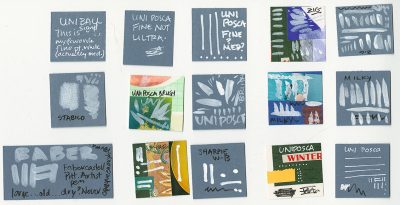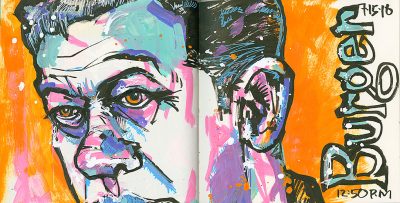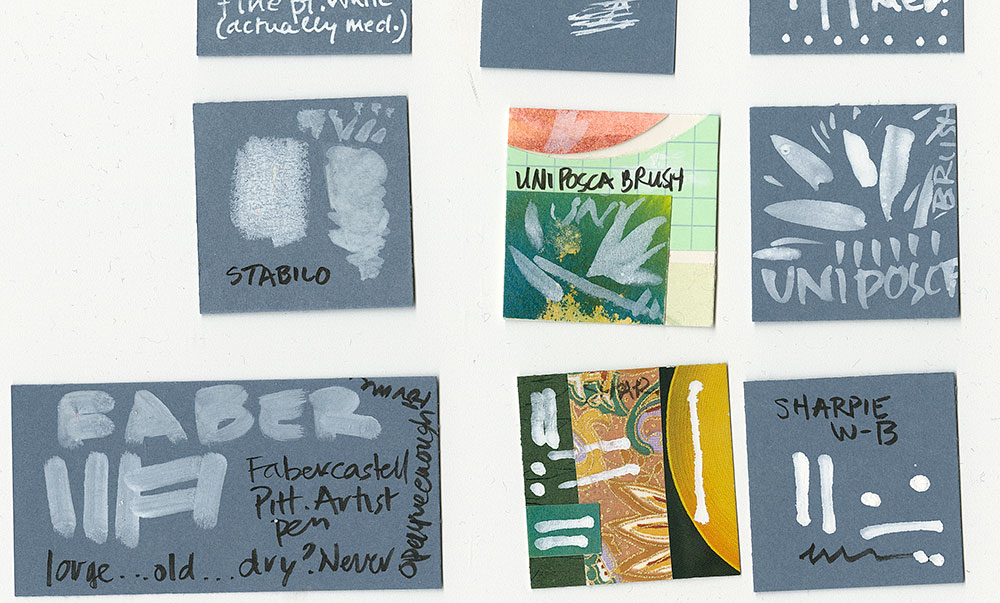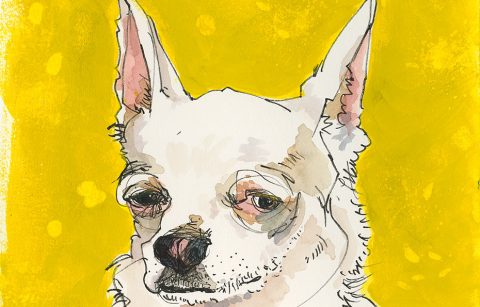 Last fall I was involved in a little grid project (rather a series of projects I was sharing and am sharing with my Patreon subscribers) I ended up with a lot of little collage squares leftover.
Last fall I was involved in a little grid project (rather a series of projects I was sharing and am sharing with my Patreon subscribers) I ended up with a lot of little collage squares leftover.
And some blue paper squares leftover.
And, as is apt to happen when you have squares of color paper laying on your drawing table you start to look around for white pens.
And of course none of them work because you’ve left them untended for too long and they have dried out; OR because you are really committed to gouache for the whites in your paintings so you have thrown many pens away; OR you lost things in transit while moving. Or any and all of the above.
So I found myself with squares, some pens I picked up in the store to replace dried pens, and some new pens I was hoping would work for me.
I did the following tests of the pens, testing the pens on a mix media toned paper as well as on a collage card with different types of papers.
I actually taped all the tests. But you know what. I think it all comes down to this “chart” of squares. And no one, especially me and you needs to listen to me going on about different white pens.
Therefore, in a nutshell, this is what I tested: Uniball Signo (medium), Uni Posca Fine (maybe medium; and later at the base of the chart, an ultra fine), Zig, Milky, Uni Posca Brush Pen, Stabillo (only one card—it’s actually the Woody now; a wax soluable pencil. I find this is amazingly versatile and you can pick up the white from the tip of the pencil with your water brush, even to high saturation levels, but I wasn’t patient on this day.); Faber Castell Pitt Artist’s Brush Pen, and the Sharpie Water-Based Poster Paint Pen.
 I think the Sharpie Water-Based Poster Paint Pen is my favorite. The most opaque. It’s water-based so it is not odiferous like solvent-based sharpies. Most of the work I’ve done with this brush is in this blog’s non-public archive, so I can’t point you to much. I’ve included a fun sketch I did with it where the pen leaked. Yes they can leak when you shake them (always cap them!) or push on them to pump them. I like that and let it happen. The white areas of the face have NO paint on them. Look for the white pen in the splashes of dots and in the highlight areas like the nose.
I think the Sharpie Water-Based Poster Paint Pen is my favorite. The most opaque. It’s water-based so it is not odiferous like solvent-based sharpies. Most of the work I’ve done with this brush is in this blog’s non-public archive, so I can’t point you to much. I’ve included a fun sketch I did with it where the pen leaked. Yes they can leak when you shake them (always cap them!) or push on them to pump them. I like that and let it happen. The white areas of the face have NO paint on them. Look for the white pen in the splashes of dots and in the highlight areas like the nose.
This pen used to be everywhere and I now find it difficult to find in the tip sizes I like to use. Maybe it’s on it’s way out…
The new pens I was testing in this group were the Zig Brush and the Milky Brush pen. I found them at Jet Pens when looking up white pens. I don’t care for either. Neither has much of an odor but they are also pretty wimpy for coverage.
For White brush pen coverage I prefer the Uni Posca’s brush pen. It has a nice pump feature and a safety cap for the base of the pen so it doesn’t pump itself in your back pack!
The Faber-Castell Pitt Artist’s Brush pen is always a disappointment to me it doesn’t have the coverage I want. But I’ve watched Don Colley (who is a master of drawing and of using Faber-Castell Pitt Artist’s Brush pens). He seems to get a lot more out of his white FCPAB pen than I do. I’m willing to accept that I either let the pens get too dry or I don’t have the knack. Try them out and see if you like them.
I still use Montana Markers with their water-based acrylic paint/ink. However I never use their white. It doesn’t flow or cover the way I want. I love all their other colors but their white has never worked for me. I love all their other colors so I suspect I just didn’t keep the white flowing. Keep that in mind if you use them.
What Do I Typically Use If I Need a White Ink Pen?
I use the Unibal Signo for light lines and some eye highlights if I’ve lost the highlights while painting. I’ll also use the Uni Posca for that as well. (I have to admit that typical use of the Uni Posca for me is as a color-coded note taking device in my day planner. [I have about 12 colors in 3 tip sizes each that have lasted me for several years!] Once in awhile I try them for something else, but they usually just end up for that purpose.)
I will also use Ziller Acrylic ink in white with a dip pen, but during the move the bottle was stored and I just can’t seem to crack it open again. I don’t know that I will replace it.
How I Really Feel about White Ink/paint
White ink and paint is a tool like so much that we deal with every day. And if it helps us get the idea in our mind down on paper then I think we need to use it.
I prefer, to reserve the white of the paper and not use white paint or ink at all.
But I also like to work on toned paper and then white paint or ink is very useful.
White color pencil can be useful for working on toned paper and for bring back very fine highlights on all paintings and drawings. I like to use the Derwent Drawing line’s white pencil. It’s softer than the Berol Prismacolor’s I usually use. But I will also use the Berol Prismacolor white. And I have a Conté Pastel Pencil in white for non-journal work. (It smudges so I don’t like to use it in my journal.)
When working with gouache to paint a portrait then white gouache (both zinc white and titanium white for different purposes), works well for different highlights, including work around the eyes in a portrait. But I still will often use some white ink from a fine-tipped pen around the eyes—it depends on how clearly my eyes are seeing!
Look, my vision isn’t what it was for a host of reasons. Sometimes, often (?), I get sloppy laying in my washes and lifting color is not going to take care of the situation, so it’s good to have some white paint or ink around.
I’ve written about white gouache before and Dr. Ph Martin’s Bleedproof White and ProWhite are both heavy duty opaque gouache used by illustrators. Pull out the amount you need with a clean spatula and place it on your palette to work with it from there. Do this and you won’t contaminate the jar and it will last you for ages!
In a pinch a bit of white acrylic gesso makes a good white paint. For that matter, white acrylic paint may do all that you need in a small, saturated line or spot—but it might not have the opacity you need, so I mention gesso.
On some papers, instead of trying to draw in a very thin line with a white ink pen try scratching into the paper to get to the white core. It might be a better route. But make sure the paper is totally dry, your X-Acto blade sharp, and of course practice first on scraps of your same paper to get the hang of it.
For really fine lines of white that you’re trying to add I’d recommend using a dip pen and Ziller Acrylic White ink. (It doesn’t smell like the white inks comics artists use.) I recommend you use the dip pen because with a very fine nib and light pressure you can put in a lot of very light, thin lines more quickly and accurately than with a brush (even with a really thin 5/0 brush or whatever) and gouache.
If you’ve practiced with gouache a lot and don’t want to switch, don’t. Don’t fix something that isn’t broken. Just be aware of some options. (This goes for whatever you are using.)
As for the white inks sold for comics artists—all of them are typically ultra opaque because they want to block thick black ink lines. BUT all the brands I’ve sampled are also high odor—that rules them out for me. If your nose can take it and you need something ultra opaque seek them out.
Always ask yourself if the white you apply will have additional work done over it and around it—and if so, is it waterproof/water resistant. A quick test of that aspect of your pen will save a lot of gnashing of teeth later.
And always test what you want to use on some scrap that has the similar conditions: paper, paper color, other marks, etc.
These small tests you do first will save you from sad discoveries that acrylic ink doesn’t look good to your eye when applied next to gouache; or that Uni Posca pens aren’t fine enough (even the ultra fine) for getting the line width you needed; or that the pen you selected just didn’t have the opacity you needed.
With practice and a small selection of options you’ll find the solutions to your white paint and ink needs.
If you have a favorite white ink pen that is low odor and has great opacity, please pop a note in the comments section. I like to keep my options open!























My go to white is Liquitex acrylic gouache titanium white with a 00 brush only for this. I gave up on white pens.
Barbara, thanks for letting me know this. Liquitex is one of the acrylic paint brands that is too odiferous for me so I can’t go that route.
I have a love/hate with every white pen I’ve tried. The Uni Posca makes me so angry… it’s the best in opacity, but eventually it clogs (the one with the finest point that I especially like). I have wasted so many. So I end up going back to the Sakura Gelly Roll, but it’s only so-so. A good opaque white pen hasn’t yet been invented. (I agree about the F-C Pitt… not at all opaque — more like translucent.)
Thanks for suggesting the Sakura Gelly Roll, I think that’s a good pen but they don’t last very long for me, they get all dried out in a couple of days despite my being scrupulous about capping them. I don’t understand it. I just have better luck with the the Uni-ball Signo.
If you can find it I highly recommend the Sharpie Poster Paint Water-based Marker. It’s way more opaque than the Uni Posca and the water based version has no odor in white. (I have found the color ones of that line do have a slight odor, but nothing like the solvent based pens of Sharpie and other lines.)
I’m glad I like gouache and aways have some around. I just keep coming back to it.
I’m glad I’m not the only one having trouble with the White F-C Pitt! Thanks for writing.